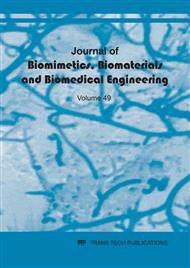[1]
C. Tanner, J. A. Schnabel, D. L. G. Hill, D. J. Hawkes, M. O. Leach, and D. R. Hose, Factors influencing the accuracy of biomechanical breast models,, Med. Phys., vol. 33, no. 6Part1, p.1758–1769, (2006).
DOI: 10.1118/1.2198315
Google Scholar
[2]
P. Wellman, R. D. Howe, E. Dalton, and K. A. Kern, Breast tissue stiffness in compression is correlated to histological diagnosis,, Harvard BioRobotics Lab. Tech. Rep., p.1–15, (1999).
Google Scholar
[3]
A. Samani and D. Plewes, A method to measure the hyperelastic parameters of ex vivo breast tissue samples,, Phys. Med. Biol., vol. 49, no. 18, p.4395, (2004).
DOI: 10.1088/0031-9155/49/18/014
Google Scholar
[4]
T. A. Krouskop, T. M. Wheeler, F. Kallel, B. S. Garra, and T. Hall, Elastic moduli of breast and prostate tissues under compression,, Ultrason. Imaging, vol. 20, no. 4, p.260–274, (1998).
DOI: 10.1177/016173469802000403
Google Scholar
[5]
F. S. Azar, D. N. Metaxas, and M. D. Schnall, A deformable finite element model of the breast for predicting mechanical deformations under external perturbations,, Acad. Radiol., vol. 8, no. 10, p.965–975, (2001).
DOI: 10.1016/s1076-6332(03)80640-2
Google Scholar
[6]
C. Tanner, J. H. Hipwell, and D. J. Hawkes, Statistical deformation models of breast compressions from biomechanical simulations,, in International Workshop on Digital Mammography, 2008, p.426–432.
DOI: 10.1007/978-3-540-70538-3_59
Google Scholar
[7]
M. A. Lago, F. Martinez-Martinez, M. J. Ruperez, C. Monserrat, and M. Alcaniz, Breast prone-to-supine deformation and registration using a time-of-flight camera,, in 2012 4th IEEE RAS & EMBS International Conference on Biomedical Robotics and Biomechatronics (BioRob), 2012, p.1161–1163.
DOI: 10.1109/biorob.2012.6290683
Google Scholar
[8]
L. Han et al., A nonlinear biomechanical model based registration method for aligning prone and supine MR breast images,, IEEE Trans. Med. Imaging, vol. 33, no. 3, p.682–694, (2013).
DOI: 10.1109/tmi.2013.2294539
Google Scholar
[9]
T. P. B. Gamage, V. Rajagopal, P. M. F. Nielsen, and M. P. Nash, Patient-specific modeling of breast biomechanics with applications to breast cancer detection and treatment," in Patient-Specific Modeling in Tomorrow,s Medicine, Springer, 2011, p.379–412.
DOI: 10.1007/8415_2011_92
Google Scholar
[10]
T. Carter, C. Tanner, N. Beechey-Newman, D. Barratt, and D. Hawkes, MR navigated breast surgery: method and initial clinical experience,, in International Conference on Medical Image Computing and Computer-Assisted Intervention, 2008, p.356–363.
DOI: 10.1007/978-3-540-85990-1_43
Google Scholar
[11]
A. P. Del Palomar, B. Calvo, J. Herrero, J. López, and M. Doblaré, A finite element model to accurately predict real deformations of the breast,, Med. Eng. Phys., vol. 30, no. 9, p.1089–1097, (2008).
DOI: 10.1016/j.medengphy.2008.01.005
Google Scholar
[12]
M. Eder et al., Comparison of different material models to simulate 3-D breast deformations using finite element analysis,, Ann. Biomed. Eng., vol. 42, no. 4, p.843–857, (2014).
DOI: 10.1007/s10439-013-0962-8
Google Scholar
[13]
Jože Korelc, AceGen and AceFEM,, 2019. [Online]. Available: http://www.fgg.uni-lj.si/Symech.
Google Scholar
[14]
A. F. Bower, Applied mechanics of solids. CRC Press, (2009).
Google Scholar
[15]
F. S. Azar, D. N. Metaxas, and M. D. Schnall, Methods for modeling and predicting mechanical deformations of the breast under external perturbations,, Med. Image Anal., vol. 6, no. 1, p.1–27, (2002).
DOI: 10.1016/s1361-8415(01)00053-6
Google Scholar
[16]
L. Ruggiero, H. Sol, H. Sahli, S. Adriaenssens, and N. Adriaenssens, The effect of material modeling on finite element analysis of human breast biomechanics,, J. Appl. Biomater. Funct. Mater., vol. 12, no. 1, p.27–34, (2014).
DOI: 10.5301/jabfm.2012.9337
Google Scholar
[17]
K.-J. Bathe, Finite element procedures. Klaus-Jurgen Bathe, (2006).
Google Scholar
[18]
H. M. Yin, L. Z. Sun, G. Wang, T. Yamada, J. Wang, and M. W. Vannier, ImageParser: a tool for finite element generation from three-dimensional medical images,, Biomed. Eng. Online, vol. 3, no. 1, p.31, (2004).
DOI: 10.1186/1475-925x-3-31
Google Scholar
[19]
S. Zaeimdar, Mechanical characterization of breast tissue constituents for cancer assessment., Applied Sciences: School of Mechatronic Systems Engineering, (2014).
Google Scholar
[20]
L. Han et al., Development of patient-specific biomechanical models for predicting large breast deformation,, Phys. Med. Biol., vol. 57, no. 2, p.455, (2011).
Google Scholar
[21]
S. Raith, M. Eder, F. Von Waldenfels, J. Jalali, A. Volf, and L. Kovacs, Finite Element Simulation of the Deformation of the Female Breast Based on MRI Data and 3-D Surface Scanning: An In-Vivo Method to Assess Biomechanical Material Parameter Sets,, in Proceedings of the 3rd International Conference on 3D Body Scanning Technologies, Lugano, Switzerland, 2012, p.16–17.
DOI: 10.15221/12.196
Google Scholar
[22]
S. Pianigiani, L. Ruggiero, and B. Innocenti, An anthropometric-based subject-specific finite element model of the human breast for predicting large deformations,, Front. Bioeng. Biotechnol., vol. 3, p.201, (2015).
DOI: 10.3389/fbioe.2015.00201
Google Scholar


